
THE POINTING DOGS
The seven popular pointing dogs shown above are the subject of Sports Illustrated's concluding lesson in how to train the sporting breeds. While the Brittany, Weimaraner and German short-hair are relative newcomers on the American hunting scene, the Irish, Gordon, and English setters are oldtime favorites now making a comeback in the field after years of overbreeding for show. They have the same natural instinct for finding birds as the pointer, who has dominated quail shooting for decades, but like the flushing spaniels, trailing hounds and retrievers considered earlier, they must, of course, be trained to do so. With patience and a little practice, this training can be for the hunter as well as the dog a rewarding and exciting experience.
GEORGE STYMIEST
A hunter and outdoorsman since boyhood, George Stymiest, 47, first became interested in training pointing dogs while he was with the Police Department of Lambertville, N.J. When, in 1939, he won the National Amateur Field Trial Championship with a pointer named Lebanon Tim, Stymiest decided to leave the police force to work with dogs full time. Since then he has trained close to a thousand bird dogs at his kennels in Lambertville, entered more than 500 field trials and twice won the National Pheasant Shooting Dog Championship.
First time in the field
The best time to begin training a pointing dog is when he is between 8 and 15 months old, after he has learned to respond to his name and to obey simple home commands (SI, July 14 and 21, 1958). Always take the dog to the field on lead so he understands you are the boss, and review his basic commands before unleashing him. Then let him run free to get him accustomed to all kinds of terrain. If he is timid about entering heavy cover, go in first and encourage him by calling him in after you. Acquaint him with gunfire by shooting a .22-caliber blank pistol from time to time. When the dog gets out too far ahead of you, blow a single blast on a training whistle to make him stop, and then send him off in a new direction by moving your arm in a sweeping motion (Field Training: Part I, June 15). The distance the dog will range from you when actually hunting is usually determined by how he is trained now. Decide in advance whether you want a wide-ranging dog (100 to 200 yards) or one who ranges close (40 to 60 yards)—this depends on the kind of hunting you will eventually do—and stop him at approximately the same distance from you each time. In this way the dog will learn the general limits of the area you expect him to cover. When you want the dog to return to you, stop him with the whistle, then stoop down and call him to you by name. Remember to praise him when he reaches you. At this stage of training, it is unimportant whether the dog points or not. Right now you are primarily concerned with teaching him to obey your commands in the field and to gain experience in hunting all kinds of cover. Spend a half hour every day for about two months on this training.
First time on point
When a dog has learned to investigate all kinds of cover and to range within your hunting limits, he is ready to begin pointing birds. In this exercise a single quail ($2.50) can be used over and over again if you tie a short string attached to a piece of wood to its leg. This won't hurt the bird but will prevent it from flying very far. Tuck the quail's head under its wing and plant it in a clump of grass. Put the dog on a 50-foot rope and lead him toward the bird. Remember that he has to face into the wind to get the scent. When he does, he will instinctively go on a natural point. Then talk to him to keep him steady as you move your hands down the rope to his collar. Holding his collar to control him, improve his form by straightening his hindquarters, lifting his forepaw and raising his head. Still talking to the dog, slowly move up ahead of him and flush out the quail with your foot. If the dog remains on point, fire the pistol. If he breaks—and he probably will at first—command "Whoa" and jerk on the rope. Plan on four months of daily training before the dog really learns to hold steady on point.
First experience hunting birds
When you have confidence that the dog will hold a point without breaking, you can proceed to teach him to find a bird in cover and point it without the control and assistance of the rope. A few minutes before taking the dog a field, plant a quail (again use the string and stick for this exercise) under some brush. Release the dog and encourage him with your voice to hunt. If at first he has difficulty locating the bird's scent by himself, direct him to the quail with your arm and body. Wear a bright-colored vest or shirt so the dog can see you easily. When he scents the bird and goes on point, move in to him. Stroke him to steady him and anticipate a break by saying "Whoa." Improve his form if necessary. Then move ahead and flush the bird. When it is in the air, fire the pistol. Continue to steady the dog with your voice and wait a few minutes after firing to make certain he has held the point. Then reward him, and send him off again to hunt the same quail in whatever direction it may have landed. Spend about two months of half-hour sessions on this stage of training.
First experience shooting birds
Before the dog can go on an actual hunt, he must gain experience at having birds shot over him. Begin this training with planted birds so you know where they are, and use a .410 shotgun until you are sure the dog is accustomed to the noise. Let him hunt on his own, keeping arm signals to a minimum. Talk to him if he runs past the bird or ranges wild. When the dog goes on point, tempt him to break by walking around a few minutes before flushing the bird. This will also teach him to hold the point so that on a real hunt, if he points a distant bird, he will remain steady until you catch up. Continue to talk to the dog as you work up to the bird. Then flush it and shoot. Walk away from the dog slowly, saying "Whoa" if he starts to follow you. Always retrieve your own birds in training. Later, when the dog is experienced and under perfect control, he can be taught to retrieve (Field Training: Part III, July 13), although this is not a job he is expected to do. When you bring back the bird, show it to the dog and let him know you are pleased with his performance.
Learning to honor a point
After the dog has hunted birds for several months, he is ready to learn to "back," or honor another dog's point. This is the finishing exercise in a bird dog's training. You will need the help of a friend and an experienced dog. Plant a bird and let the older dog point it. Then lead your dog on a rope up to within five feet of him. He may instinctively go on point when he sees the other dog. If he does not, stop him and help him into a point with your hands. When he is steady, have your friend flush and shoot the bird. Keep a grip on the dog's collar and talk to him so he doesn't break. Repeat the exercise on lead until the dog knows what you expect of him; then practice off the lead, encouraging him to back at the sight of the other dog. Eventually he will honor a point from as far away as he can see it. For the bird shooter, there is probably no more thrilling sight in the field than that of one or more dogs frozen motionless as they back another.
PHOTO
POINTER
PHOTO
ENGLISH SETTER
PHOTO
BRITTANY SPANIEL
PHOTO
GORDON SETTER
PHOTO
GERMAN SHORTHAIR
PHOTO
IRISH SETTER
PHOTO
WEIMARANER
ILLUSTRATION
DANIEL SCHWARTZ
ILLUSTRATION
DANIEL SCHWARTZ
For control, take dog on lead to and from the field.
ILLUSTRATION
DANIEL SCHWARTZ
Encourage young dog to enter cover by going in first.
ILLUSTRATION
DANIEL SCHWARTZ
Bring dog back by bending down, calling him by name.
ILLUSTRATION
DANIEL SCHWARTZ
Tie siring and small slick to bird's leg to limit flying.
ILLUSTRATION
DANIEL SCHWARTZ
Put puppy on a long rope and lead up to planted bird.
ILLUSTRATION
DANIEL SCHWARTZ
When dog is on point, more hands up rope to his collar.
ILLUSTRATION
DANIEL SCHWARTZ
Then flush out bird with foot and fire training pistol.
ILLUSTRATION
DANIEL SCHWARTZ
Steady dog with voice and use hands to improve form.
ILLUSTRATION
DANIEL SCHWARTZ
Help dog locate bird by signals with arm and body.
ILLUSTRATION
DANIEL SCHWARTZ
Dog will go on instinctive point when he scents bird.
ILLUSTRATION
DANIEL SCHWARTZ
If dog holds point, flush bird and fire blank pistol.
ILLUSTRATION
DANIEL SCHWARTZ
Move slowly up to dog and steady him on point.
ILLUSTRATION
DANIEL SCHWARTZ
To test dog on point, wait before flushing the bird.
ILLUSTRATION
DANIEL SCHWARTZ
Steady dog by voice as you flush and shoot quail.
ILLUSTRATION
DANIEL SCHWARTZ
Always retrieve dead bird in training to show dog.
ILLUSTRATION
DANIEL SCHWARTZ
Dogs honor point of Irish setter as hunter walks up to flush bird.

